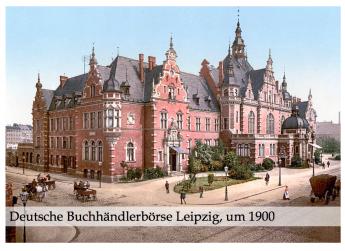News & Updates
Books and Bombs - Book City Leipzig on 4th December 1943

The 4th December marks the 75th anniversary of the destruction of the Graphisches Viertel, the bookseller's quarter in Leipzig. At that time the centre of the German book trade was destroyed by explosive and incendiary bombs in just under two hours (air raid alarm: 3:39 a.m.; all-clear: 5:32 a.m.). More than 1,800 people died that night, 114,000 Leipzig residents were left homeless, 15,000 buildings hit. The largest publishing houses - among them F. A. Brockhaus Verlag, Philipp Reclam jun. and Breitkopf & Härtel, the oldest music publisher in the world - burned out and with them an estimated 50 million books. The Deutsches Buch- und Schriftmuseum (DBSM), the oldest book museum in the world, was a ruin, the seat of the Börsenverein der Deutschen Buchhändler was destroyed, and the Deutsche Bücherei, the German National Library was badly hit: With the Allied bombing raid, Leipzig finally lost its centuries-old reputation as a "book city", which had already been thoroughly shaken by the First World War.
Arthur Luther, literary scholar, survivor of the bombing raid and head of department at the German Library, wrote in his diary on December 4, 1943: "Flying noise... The ceiling collapses with terrible noise, I fall on my back... Glasses off, hat off... Finally the crash and shooting stops. We dare to go out. First impression flames everywhere and screaming people. I go to the library. The east wing strongly taken along. All windows smashed. Smoke rises from the basement. The window frames in the east wing after the Deutsches Platz too burnt out. The large reading room full of shards, rubble and debris. The murals by L. Hofmann no longer exist. Since no window is intact, icy cold in the whole building. Post office, museum, university, opera in flames or in ruins. The Brühl destroys, the Old Theatre a ruin... But above all the whole booksellers' quarter "shaved away": all the big publishing houses, all the big printing houses, booksellers' house, book museum etc.".
This "book museum", today the German Book and Writing Museum of the German National Library, had its rooms in the representative bookseller's house, where three years earlier the museum had celebrated and ideologically instrumentalized the 400th birthday of the "German hero" Johannes Gutenberg. On the night of 4th December, the museum lost nine tenths of its holdings. The most precious pieces could be moved to the Erzgebirge mountains shortly before, survived the war there and were taken by the Soviet army to Moscow in the first post-war months, where they still lie today.
The DBSM takes the 75th anniversary of the bombing of the Graphisches Viertel as an opportunity to commemorate the destruction with two projects:
On the one hand, the museum places one of the few objects that could be recovered from the ashes of the bookseller's house with traces of powder at the beginning of December 1943 in the centre of an installation: it is a granite stone weighing several hundred kilograms with Chinese characters around 3,000 years old. At the beginning of December this year, the "GNDCon" in Frankfurt am Main will focus on the so-called stone drum, the splinters and traces of which still bear witness to the destruction, at a congress that focuses on the principle of open, cooperatively developed and networked standards data as points of orientation on the Internet and seeks to promote cooperation with online communities, museums, archives, publishing houses and universities - a piece of the future for the cooperative development of the museum's cultural heritage as well. In this context, the Steintrommel stands for an outstanding example of an extremely rich, interdisciplinary world of knowledge that is bundled in a single object. From the beginning of 2019, the exhibit will again be on display in the permanent exhibition of the DBSM in Leipzig - enriched and presented in a cloud of interdisciplinary metadata that explain and contextualize the multi-layered object.
The second project deals with a review of Leipzig as the "Capital of Books" at the beginning of the 20th century. For this purpose, 2,200 company locations of the Graphisches Viertel were transferred from the Leipzig Address Book of 1913 into a database. In cooperation with the Office for Geoinformation and Land Order, Department of Digital Cartography of the City of Leipzig, these data have been prepared for presentation on a digital map. To mark the anniversary of the destruction of the booksellers' quarter, the map will be activated on www.leipzig.de and presented at the beginning of December at the 2nd Digital Humanities Day of the Forum for Digital Humanities Leipzig and the Academy of Sciences Leipzig.
Traces of the war are still visible today in the former Leipzig booksellers' quarter: large brownfields and ruined houses remind us of the destruction of the Second World War. Above all, however, today's visitor is confronted with numerous new building projects, some of which involve historical building remains - such as the reconstruction of the former book trade building.
More information about the project can be found on the website of the German National Library: www.dnb.de
